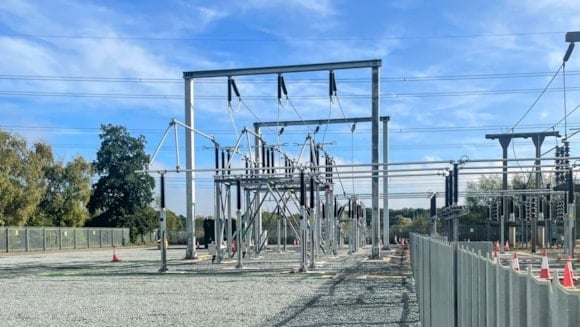National Grid has upgraded its Drax 132kV substation to enable the connection of TagEnergy’s 100MW/200MWh battery energy storage system (BESS).
According to the renewable energy developer, the North Yorkshire facility is the largest transmission-linked battery storage system in Britain. National Grid worked with contractor Omexom to safely facilitate the connection to the network.
The work includes extending the rails, which allow the flow of power from the generation source to the power lines, upgrading the rail protection and substation control systems, and installing an operational shutdown scheme.
The substation upgrades ensure network stability and security. The adjacent 400 kV substation houses the connection for the Drax power station, Britain’s largest biomass plant.
The BESS project is owned by TagEnergy and received support from technology supplier Tesla, optimiser Habitat Energy and independent sustainable energy company RES Group. In December 2021, TagEnergy acquired a 100% stake in RES’s Lakeside project in a deal worth £65 million.
Mark Brindley, Portfolio Director for the Northern Regions at National Grid Electricity Transmission, explains: “Our Drax substation was originally connected to a coal-fired power station in the 1970s and now plays an important role in the energy transition – by not only being the largest battery in the country, but also the largest biomass power plant.”
Franck Woitiez, CEO of TagEnergy, said: “We are proud to have delivered the project efficiently, energetically and connected to National Grid’s transmission network, without significant delays or operational issues. That is exactly what is needed to accelerate the transition.”
Grid connections that are crucial for clean energy
While there were no significant delays to the Lakeside BESS transmission link, the queue of projects waiting to be connected to the UK electricity grid is around 722 GW.
As reported by our sister site Current±, the British energy regulator Ofgem has made proposals for a system overhaul to speed up the connection process, which is widely recognized as a major barrier to net zero.
Infrastructural changes will also require an impetus. To support this, National Grid launched the ‘Great Grid Upgrade’ initiative in 2023. The aim is to build new infrastructure across England and Wales so that more clean energy can be transported from generation sites to where it is needed.
National Grid has committed to this investing £60 billion in network and grid upgrades over the next five years, on both sides of the Atlantic Ocean. By 2029, around £30 billion will be invested in Britain, while £28 billion will be invested in the US North East.


